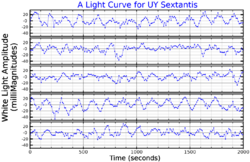Astronomy:PG 1047+003
From HandWiki
Short description: Subdwarf B star in the constellation Sextans
 A white light light curve for UY Sextantis, adapted from Billeres et al. (1997).[1] All five panels form a single 10,000 second light curve, with the top panel continued on the second panel, etc. | |
| Observation data Equinox J2000.0]] (ICRS) | |
|---|---|
| Constellation | Sextans |
| Right ascension | 10h 50m 02.826s[2] |
| Declination | −00° 00′ 36.88″[2] |
| Apparent magnitude (V) | 13.47 |
| Characteristics | |
| Spectral type | sdO9VII:He6[3] |
| Variable type | V361 Hya[1] |
| Astrometry | |
| Radial velocity (Rv) | 13.6[4] km/s |
| Proper motion (μ) | RA: −20.528[2] mas/yr Dec.: −38.421[2] mas/yr |
| Parallax (π) | 1.4559 ± 0.0789[2] mas |
| Distance | 2,200 ± 100 ly (690 ± 40 pc) |
| Details | |
| Mass | 0.490±0.014[5] M☉ |
| Radius | 0.17±0.01[5] R☉ |
| Luminosity | 25.86+3.28−2.61[5] L☉ |
| Surface gravity (log g) | 5.83±0.01[4] cgs |
| Temperature | 34,850±90[4] K |
| Rotation | 24.6±3.5 d[5] |
| Other designations | |
| Database references | |
| SIMBAD | data |
PG 1047+003 is a post-AGB blue-white subdwarf star, located in the constellation of Sextans. The star is classed as member of the V361 Hydrae type (or also called sdBVr type) class of pulsators in the field of asteroseismology.[1] No additional stellar companion has been detected in tight orbit or imaged around the subdwarf star.[7]
References
- ↑ 1.0 1.1 1.2 Billeres (1997). "Discovery of p-mode Instabilities in the Hot Subdwarf B Star PG 1047+003". Astrophysical Journal Letters 487 (1): 81–84. doi:10.1086/310882. Bibcode: 1997ApJ...487L..81B.
- ↑ 2.0 2.1 2.2 2.3 Brown, A. G. A. (August 2018). "Gaia Data Release 2: Summary of the contents and survey properties". Astronomy & Astrophysics 616: A1. doi:10.1051/0004-6361/201833051. Bibcode: 2018A&A...616A...1G. Gaia DR2 record for this source at VizieR.
- ↑ Drilling, J. S. et al. (2013). "An MK-like system of spectral classification for hot subdwarfs". Astronomy & Astrophysics 551: A31. doi:10.1051/0004-6361/201219433. Bibcode: 2013A&A...551A..31D.
- ↑ 4.0 4.1 4.2 Lei, Zhenxin et al. (November 2018). "New Hot Subdwarf Stars Identified in Gaia DR2 with LAMOST DR5 Spectra". The Astrophysical Journal 868 (1): 9. doi:10.3847/1538-4357/aae82b. 70. Bibcode: 2018ApJ...868...70L.
- ↑ 5.0 5.1 5.2 5.3 Reed, M. D. et al. (March 2020). "K2 observations of the pulsating subdwarf B stars UY Sex and V1405 Ori". Monthly Notices of the Royal Astronomical Society 492 (4): 5202–5217. doi:10.1093/mnras/staa144. Bibcode: 2020MNRAS.492.5202R.
- ↑ "UY Sex". SIMBAD. Centre de données astronomiques de Strasbourg. http://simbad.u-strasbg.fr/simbad/sim-basic?Ident=UY+Sex.
- ↑ O'Donoghue; Koen; Lynas-Gray; Kilkenny; Van Wyk (1998). "The EC14026 stars - VI. PG1047+003". Monthly Notices of the Royal Astronomical Society 296 (2): 306–316. doi:10.1046/j.1365-8711.1998.01311.x. Bibcode: 1998MNRAS.296..306O.
 |

